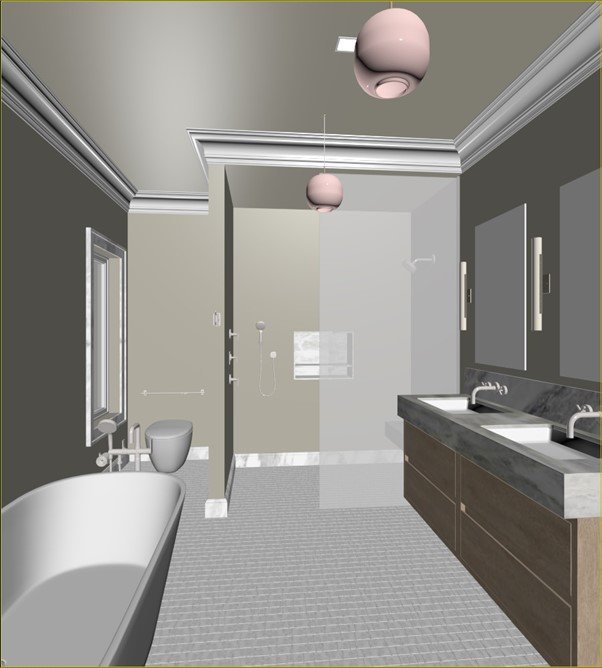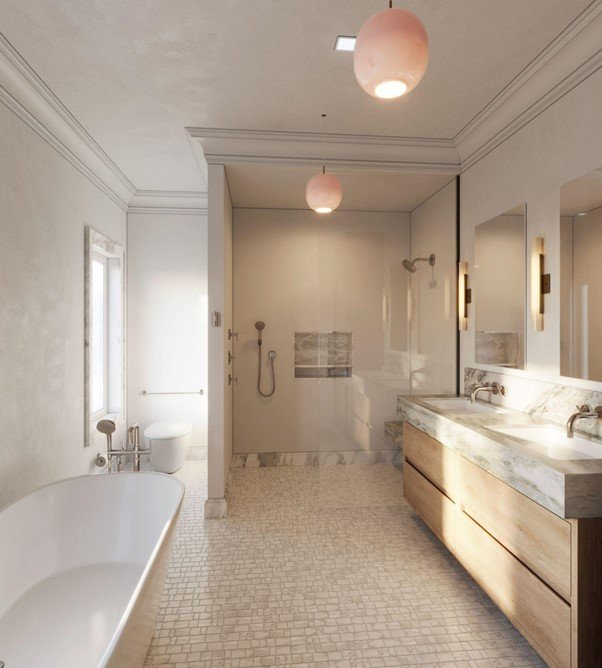Table of Contents
ToggleOverview

Boston-based Ratio Visuals recently collaborated with an interior designer on the design of a luxury bathroom. Most of the time interior experts require accurate presentations in order to assist their customers envision the end look of the finished work, and in this instance, the two views of the bathroom were required to present the designer’s concept effectively.
The materials, which were later ordered, included:
Perhaps the most important element of our interior design package was the sankayume’s sewer, countertop, kiwiya, flooring, electrical lighting, appliances and tiles’, want-to have-a-look-mood-board.



A schematic diagram that showed the arrangement of the various elements in the bathroom

Diagrammatic sketches that showed details of the construction, furnishers, and size of the walls

With such creativity involved in the construction, our responsibility was to generate 3D renders which were quite realistic in order for the interior designer and her customer to have an idea of how the bathroom would look like even before the construction work started, as we explain next in our work:
Step 1: Proposing Camera Angles
What was done first was how the bathroom would be photographed. We worked together with the designer in deciding which angles had the best view of the important aspects in the space such as the position of the sink, the shape of the countertop and the custom lighting.
After considering the options, the designer was able to approve the angles suitable for her requirements.
Step 2: Building the 3D Model and Sending Screenshots
After determining the camera parameters, the next stage was to develop the 3D model of the bathroom. This required starting with the mood board which suggested the composition of the materials like tile, floor coverings and countertop materials to be used. We ensured that every single appliance and fixture was modeled accurately in order to conform to the design specifications.


As we finished the 3D model, we took screenshots to send to the client in order to make sure that the model was up to her requirements. This was an important step since it was possible to catch any discrepancies in earlier stages and amend in the later stages rather than when all the elements are final render
Step 3: Finalizing the Renders


Once the 3D model was checked and accepted, we continued to finalize the renders. The aim was to make every corner of the bathroom visual through the application of real lights and textures – from the stones on the bar counter to the custom designed lighting, everything needed to be realistically portrayed and integrated in the design.
The interior designer appreciated the first draft of the renders. All the aspects of the mood board were correctly applied onto the 3D render, and the final outlook was precisely how she envisioned it. Thus, the project was completed without making additional changes.
How Interior Designers Gain from Utilizing 3D Renderings
Interior design is a practice that requires communicating visually, which is a big hurdle because the designer’s vision has to get across visually. Before now, designers would make a mood board, a floor plan, or even a sketch. But, here comes the 3D rendering technology meant to change the game for interior designers for the better, enhancing how interior design is done as well as how the clients are communicated to.
In what ways can 3D renders enhance an interior designer’s approach to a project?
1. Representation of Visual Effects in Real Time
Interior designing involves a LOT of intricate details and more often than not, those details can be missed. However, 3D renders can accurately depict the finer details that would otherwise remain hidden. Details like the type of carpets, the type of finish on walls and cabinets, and so on – 3D CGI can show them in the correct light, which traditional methods are incapable of accomplishing.
In the case of a bathroom project in Boston, the designer placed her fingers on the monitor and started tinkering with the design bespoke to that space – how various aspects of her design would appear in that room. This kind of accuracy is extremely helpful when you have to make critical choices regarding the construction materials, the finishes, or even the positioning of the constitutive elements.
2. Improved Client Communication
3. Faster Decision Making
Design projects on the other hand can be hindered with decision making – be it deciding on the type of tiles to use, or which fixtures to utilize and where to position them. 3D renders aid in expediting this decision making process by providing a clear and visual depiction of a specific design, making it easy and fast for both the designers and the clients to make a decision.
During the Boston bathroom project, for example, the owner was eager to see the 3D rendered model so that she could make satisfactory decisions about the materials and layout and the project could progress without interruptions.
4. Revision made Easy
There is no design process without revisions, however, these may be a hassle at times. While 3D renders, designers work with clients to make changes, as changes are incorporated envision and do them as needed. This is particularly useful when clients change their mind only minutes before a presentation – 3D rendering software allows for such changes to be made easily without wasting time doing everything all over again.
5. Competitive Advantage
In as competitive an industry as interior design, having 3D renders can give a designer a winning edge. Clients feel more inclined to select a designer who has the means and tools to create highly realistic representations of their intended design and planning, and the provision of 3D renders is in itself a suggestion of advanced practices as well as professionalism.
Taking into account the 3D renders enhances their workflow so as to be ahead in the competition and therefore, attract clients by conquering their imaginations and showcasing how the project will look like even before it’s constructed.
Frequently Asked Questions (FAQs) Related to 3D Renders for Interior Designers
In the event that mood board, floor plans and other elevation drawings that include the details of materials, fixtures, and inspiration images and so on are required in creating the 3D render. The more the details, the better the final render turns out.
In general, the first draft renders are submitted within a period of 3-5 days after receiving all the required documents and data. If there’s a need for revisions, we will be able to incorporate the changes and deliver the rendered images in one to two days.
Of course! You can make requests for the changes after getting the screenshots of the 3D models. We would make sure that your changes are incorporated in the design before completing the final Renders.
The use of 3D rendering means you can witness a realistic and complete presentation of your design before construction begins which simply means that decisions regarding the materials to be used, the layout and lighting can be completed easily. It also makes the approval of clients effortless and minimizes revisions that turn out to be expensive in the late stages of progress.
Yes, we are fully equipped to produce the 3D visualization of any interior space such as a bathroom or a kitchen, living room and bedroom, as well as structural spaces. Each render is done as per the requirements and the imagination of the designer.
Interior Rendering for Interior Designers
3D Renders for Interior Designers If you’re already made a decision to use 3D renders within your design practice, then the following is very easy and efficient. Here’s how it works:
Step 1: Providing Required Design Documents
The first thing you will do is provide:
- A mood board created with great details that shows your thought process on how the specific area will look like and contains details about materials, fixtures, colors, and textures, etc.
- The building plan along with elevations for effective understanding of the areas of focus and the size of the area in question.
- Any design style or style-related image that has a more suitable appearance than the design itself.
Step 2: Proposed Camera Angles to be Discussed
Once we have all the materials, we can now stick to the proposed camera angles and explain them in detail. These angles help us determine how the space is best highlighted in the renders.
Step 3: Building The 3D Model
As soon as the shooting angles are predetermined, we start building the 3D model of the space based on your mood board and the sketches. Before moving to the final rendering, our model screenshots are shared with the clients for comments and approval.
Step 4: First Draft Renders
Step 5: Revisions
In the event that changes are needed, the design will be altered and the updated renders will be sent to the client within one or two days. This helps to synchronize the revision stage so that the final design is as per the client’s specifications
Step 6: Final Delivery
After the last changes are made and accepted we give the final renders which can be filed for presentations before the clients or seeking design approval and even marketing the products.
Conclusion: Advancing 3D Renders in Interior Design
With the development of 3D rendering technology, the interior design sector progressed significantly with the designers finding it easy to display their work and explaining their ideas to their clients. In this way, 3D renders equipped with lifelike representation makes processes faster, enhances client communication, and reduces conflicts post construction by being able to better visualize the project.

